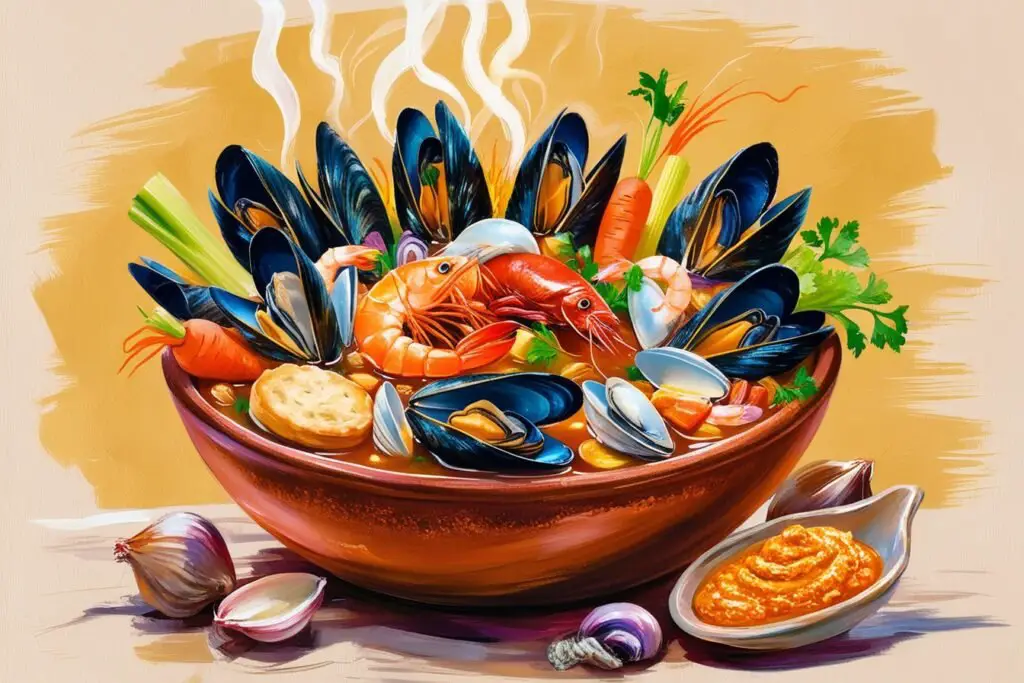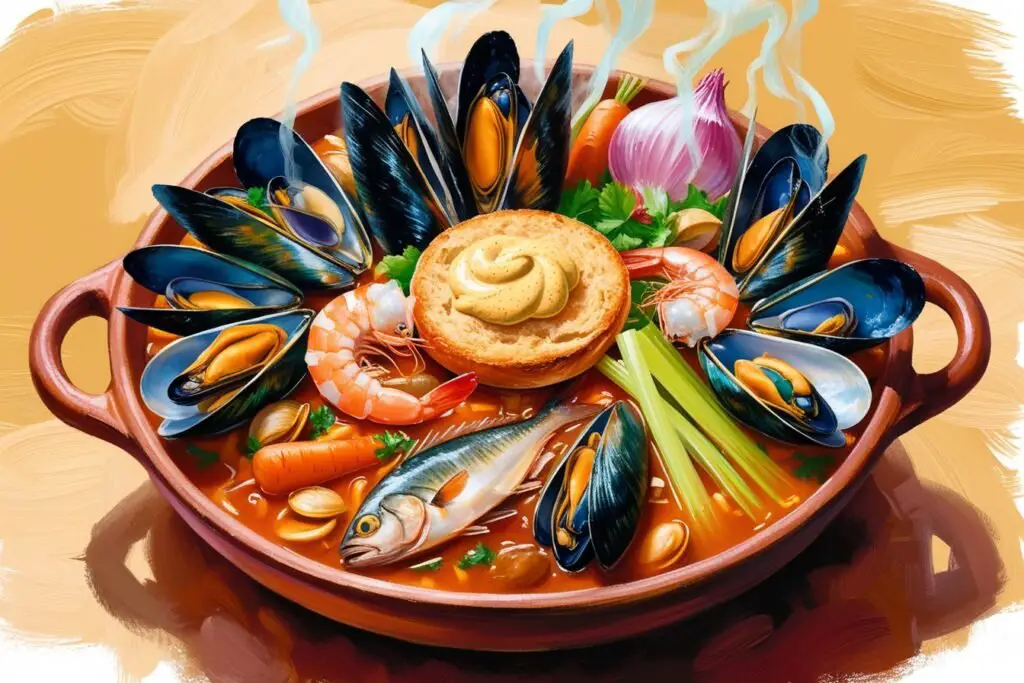Table of Contents
Introduction

Just the name Bouillabaisse makes one relate in one’s mind to pictures having to do with the summer and seascape on the Mediterranean coast. But it is so much more than a dish – this culinary history is steeped in flavor. Born in the port city of Marseille, it is this seafood stew that started as a simple fisherman’s meal and has evolved to become one of the classic dishes in French cuisine. Bouillabaisse is that sort of food dish not only in richness and fragrance of broth but also with varied fresh seafood, which depicts how deeply tradition is properly rooted.
This article takes you through the interesting history of Bouillabaisse, explains its key constituents, guides you through step-by-step preparation, and gives you suggestions on how to serve and enjoy it. You learn different variations and answer some of the most frequently asked questions about Bouillabaisse. Whether an experienced chef or a culinary neophyte, find all there is to concoct your very own Bouillabaisse masterpiece.
The Rich History Behind the Dish
Bouillabaisse dates back centuries. This is a combination reminiscent of the friendly hustling and bustling city of Marseille, where the trader and the fisherman would try their luck. Leftover remains of the fisherman, all the bony fish by-products, herbs, vegetables, and water boiled in the stew made this dish a nourishing hearty meal. The word “Bouillabaisse” itself comes from two Provençal words: the verb “bouillir,” meaning to boil, and “abaisse,” referring to reducing, essentially a doubling-boiling process. This was the technique that enabled them to cook a hearty meal out of whatever fresh ingredients were available.
As more people enjoyed the dish, cooks and chef enthusiasts began to like it too. From a rustic, everyday delicacy, Bouillabaisse moves towards becoming a more advanced piece of culinary art as a result of the inclusion of varieties of fish, shellfish, and spices. It became a popular dish through this period; it was featured in classy restaurants in the 19th century when it represented Provençal cuisine.
Today, Bouillabaisse is not only a phenomenon adored in France but also around the world. Most of the time, it is presented near coasts or seashores where catches are abundant. It is a feast of eating over a single table with many people which is why it has become a hit on festivals and other significant celebrations.
Bouillabaisse Ingrédients: What Makes It Irresistible?
In essence, Bouillabaisse is a recipe and as a rule, it is kept that way with the major components forming the basis of the preparation. From the fresh seafood to aromatic herbs and well-crafted broth, this dish tells a lot. Let’s take a closer look at the fundamental components that give rise to the depth of flavor and character that Bouillabaisse is famous for.
Essential Seafood Components
1. Fish:
Traditionally, there were a large number of fishes involved with a Bouillabaisse. The flavors and texture the fish will bring in will add to the stew. There are some commonly used choices like:
- Rockfish: This is often used in the preparation of a Bouillabaisse because of its firm flesh and pale flavor.
- Red Mullet: This is an incomparably sweet and colored fish that will help out your dish.
- Monkfish: This has a meaty texture. The dish stands up to cooking and helps to shape your soup into a heartier form
2. Shellfish:
Shellfish provides an intense salty taste. Shellfish which are most commonly used include;
- Mussels: Once cooked they infuse into the broth a delicious taste.
- Clams: These provide a subtlety of sweetness. One can taste the ocean.
- Shrimp: Its sweet mushy meat complements all seafood and boosts the palate of this dish.
Aromatic Herbs and Spices
The bouillabaisse is characterized by its great fragrance; it will be even more fragrant with a mix of herbs and spices:
- Saffron: This cost-friendly spice gives stew the characteristic golden color with complex flavor from floral notes that complement the overall odor of the dish.
- Fennel: Its anise-like sweetness makes it a versatile addition to the seafood, balancing its richness.
- Garlic: For depth of flavor in a stew like this one, garlic is a must.
- Herbs: Bay, thyme, and parsley make the dish bright with freshness and herbal perfume.
Recommended Side Dishes
Bouillabaisse is often served with a variety of accompaniments that complement its flavors:
- Rouille: This could be garlic mayonnaise blended with saffron and cayenne pepper-strong, spicy, and rich-wonderful to counterpoint the stew.
- Crusty Baguette: To enjoy that magnificent broth to its fullest advantage, a new baguette for dipping-crunching heaven with the meal.
Mastering the Art of Cooking
Although this is a recipe for Bouillabaisse and may seem almost unachievable it is well within reach given a little time and the right method. Here follows the simplified detailed cooking procedure to ease your work.
Step-by-Step Bouillabaisse Recipe
Ingredients:
- 1 lb mixed fish, including rockfish, monkfish, red mullet
- 1 lb shellfish, including mussels, clams, shrimp
- 1 large onion
- 2 leeks (only the white part)
- 2 cloves garlic
- 1 bulb fennel, sliced
- 4 large, very ripe tomatoes, chopped
- 1 tsp saffron threads
- 1 tsp dried thyme
- 1 bay leaf
- 4 cups fish stock or water
- Salt and pepper to taste
- Olive oil for sautéing
- Fresh parsley for garnish
Instructions:
- Sauté the Aromatics: Pour enough olive oil into a large pot to allow the ingredients to come to the bottom, then over a medium flame sauté the chopped onions, sliced leeks, minced garlic, and fennel. Stir for 5 minutes until vegetables become soft and give out their fragrance.
- Add tomatoes and spices: Then add the chopped tomatoes, saffron, thyme, and bay leaf. Stir really well and cook for another 5 minutes till the flavors can penetrate in.
- Prepare the Broth: Add the fish stock or water to the mixture. Season to taste with salt and pepper. Bring the broth almost to an undetectable temperature for nearly 20 minutes as the flavors deepen.
- Add Seafood: Add mixed fish and shellfish carefully in the pot. Cover and cook for another 5-10 minutes or until the seafood is done and mussels are opened. Discard those not opened.
- Taste and Adjust: Taste the broth for seasoning and add if necessary. Remove the bay leaf before you serve.
- Serve: Ladle the Bouillabaisse into warm bowls, garnished with fresh parsley. Vichyssoise can be accompanied with rouille on the side and crust bread toast for that extra feel of the original dish.
Tips for Selecting the Freshest Seafood
For a Bouillabaisse to be that great you have to make sure that the seafood used are fresh to the highest degree. Here are some tips to consider:
- Visit Local Fish Markets: Your local fish markets and quality seafood stores should provide the best options available to you. After servings are asked what it is they should go for and concerning shellfish, the shellfish should still be alive and concerning fish, and the fish should have bright clear eyes.
- Freshness indicators: A fresh catch should have that salty, clean smell, as if just in from the ocean; it must not have that strong fishy smell. The flesh should be firm, and springy when pressed.
- Seasonality Matters: In this case, it is recommended that one buys his or her seafood in season to afford the best taste while at the same time helping to conserve the fishing industry.
Common Mistakes to Avoid While Cooking Bouillabaisse
- Overcooking the Seafood:
Cooking it too long is dangerous; seafood will go stringy and rubbery. Cook till it is opaque and tender. - Ignoring the Broth:
The broth is the very heart of Bouillabaisse care not to skimp on flavoring it. Take the time you’re allocated to allow the aromatics and spices to steep into the liquid. - Rushing the Process:
Finally, let the stew stand; this is where I always say that doing nothing is the best part of cooking delicious stew. Remember also that you should give enough time to your broth so that the ingredients are incorporated well into it.
Check Out: Delicious Depths: Exploring the World of Fish Soups.
Serving Bouillabaisse: Presentation Matters!
Once your Bouillabaisse is perfectly cooked, here are a few suggestions on the presentation to vary and make an enormous difference in dining. Here are a few creative ways of serving this lovely dish.
Creative Plating Ideas for an Eye-Catching Dish
- Rustic Bowls: This stew is best served in rustic bowls that appeal to the soul of Provence. You want to serve in bowls that will show off your seafood brightness and your colors in the broth.
- Garnish Liberally: A sprinkle of fresh parsley or chives over the top gives a shot of color and freshness to the dish. Do not forget that a splash of lemon peel can elevate panache.
- Side Dishes: Serve toasted baguette slices with a small ramekin of rouille to dip into. In this case, the textural play doesn’t add to the experience.
Suggestions for Pairing Wine with Bouillabaisse
The right wine can complement your experience with bouillabaisse. Check out these pairings:
- White Wines: A crispy Sauvignon Blanc or buttery Chardonnay is great together for seafood and does not set back aromatic broth.
- Rosé: A chilled rosé will offer contrasting refreshments to the rich stew, complementing light fruity notes with contrasts to heighten your enjoyment at the table.
Variations of Bouillabaisse: Explore Different Flavors

Even though classic Bouillabaisse is a standard ingredient, by all means, you should not be afraid to attempt many of the many variations. This recipe lends itself very well to being adapted to your taste or requirements based on diet.
Regional Variations Across France and Beyond
- Bouillabaisse de Marseillaise: The prototype one is from Marseille, which is made with regional fish products and a true spice building the real taste of that specific recipe. This one usually has a rouille layer on top.
- Bouillabaisse Niçoise: Nice is another regional variation; this one may contain additional vegetables such as potatoes and carrots so almost a more filling version of the classic Bouillabaisse.
Vegetarian or Vegan Adaptations of Bouillabaisse
Vegetarians or vegans who do not want to tolerate the fishy flavor may like to prepare a vegetable variant of the Bouillabaisse.
- Base Ingredients: Use vegetable broth instead of fish broth and include strong vegetables including zucchini, potatoes, and bell peppers.
- Seaweed: Seaweed or mushrooms may also be added in the recipes and there is a sense of umami that will add to the dish which can be utilized to replace the flavor of fish in seafood without using fish.
Conclusion
In effect, bouillabaisse is a celebratory gesture rather than just a dish-a celebration of the coastal settings and flavors, and pure enjoyment in the culinary tradition. Mastering the recipe will therefore not only yield a great meal but also a dish so heavily laced up with history and cultural significance that honoring the tradition becomes the gesture to serve it. Bouillabaisse shared among family, and friends, or during special occasions promises to impress everyone who tastes it and leave them satisfied.
After all, cooking is an art and science where creativity and experimentation would be equal to some measure of following a recipe: pour in your own creativity and twist it into the dish to personalize your favorite flavors. A good creation is best shared with friends and savor the camaraderie that embodies the spirit of Bouillabaisse, and now.
For more details: Click Here.
FAQs
What seafood is best for Bouillabaisse?
For Bouillabaisse, the best seafood is firm fish such as rockfish or monkfish along with shellfish which comprises mussels, clams, and shrimp all together bursting with flavors and textures.
Can I make Bouillabaisse in advance?
Yes. Bouillabaisse can be prepared beforehand but not the seafood since it cannot bear the heat for long. It has to be added just before serving. For instance, you can prepare the broth and the vegetables in advance and add the seafood when you want them to be ready, say, just several minutes to the end.
What are traditional accompaniments for Bouillabaisse?
Typically, rouille and break accompany the dish, providing a complement to the meal, and helping to consume the flavorful broth.





